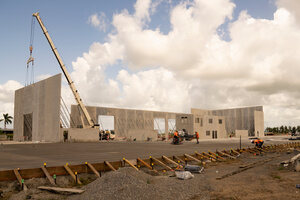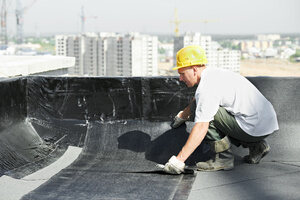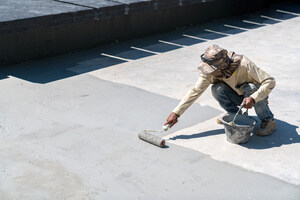Commercial structures bear their immense weight down on the ground and, beneath that, the foundation on which the building is constructed. Taking care of this foundation and conducting regular preventive maintenance is critical for preventing costly and difficult repairs later on. One of the most important things that you can do to protect your building’s foundation is to invest in commercial waterproofing.

When water meets a foundation, it can expand or swell the ground around it, causing cracks and heaving in the foundation. At best, this can make your commercial building’s floor inconveniently uneven-but at worst, a water-damaged foundation will lead to structural problems that could make your building too dangerous to use.
Investing in waterproofing is one of the smartest maintenance decisions you can make for your foundation. The best time for commercial waterproofing for your foundation is when it’s still being built, but the second best time is now. Here are five ways to waterproof the foundation of your commercial building.
Fluid-Applied Waterproofing
As the name suggests, fluid-applied waterproofing will use a specialty solution painted onto your foundation that will cure into a waterproof surface. It works best on concrete, which is also the most common choice for foundations. However, because the concrete must be exposed in order to receive this treatment, fluid-applied waterproofing is only an option for buildings that are still under construction and whose foundation has not yet been submerged underground.
Bentonite Membrane Waterproofing
Bentonite waterproofing is another technique that works by applying a film over the exterior concrete-meaning that it must be done while the material is exposed during construction. However, unlike fluid-applied solutions, bentonite membranes don’t repel water. Instead, they work to absorb it so that the water never reaches the concrete underneath. Bentonite is a type of clay mixture, and clay is notoriously good at absorbing water.
Sheet Waterproofing

Sheet waterproofing relies on the bond between a fabric layer that adheres to the concrete and a watertight barrier on the other side. Many companies like this option because the waterproof sheet will repair itself if a puncture should happen thanks to an actively adapting core within the sheet. The best time to install sheet waterproofing is before construction completes, when you still have full access to the foundation surfaces.
Negative-Side Waterproofing
Not all businesses have the luxury of waterproofing during the construction stage. When a contractor cannot reach the external surfaces of your foundation, the next best step is to waterproof the negative side-that is, the interior.
This serves all of the same purposes as waterproofing the exterior, except that the material of choice stops water from making it into the inner parts of the foundation or basement. This will not necessarily prevent cracking or other problems that occur on the positive side (the external surfaces of the foundation which can’t be reached), but it can stop damage from continuing further into the center of the structure.
Integral Crystalline Waterproofing
Almost all waterproofing options for commercial masonry and foundations rely on applying a material that adheres to the surface of the foundation itself, either on the positive (external) or negative (internal) sides. Whether this is a membrane, a sheet, clay or something else, these practices take normal concrete and apply a coating to it. Integral crystalline waterproofing, on the other hand, is a way of making the concrete itself waterproof.

Because of this,ICW is only an option for buildings that are still under construction-and specifically, during the stage when the foundation has not yet been constructed. However, this unique concrete mixture is structured in such a way that the matrix of the concrete is itself waterproof. The material will repel water on its own, and depending on the type of integral crystalline waterproofing, it may even have the capacity to minorly repair itself or fix cracks on its own even after the concrete has already cured and stabilized.
ICW is a more expensive option than standard concrete upfront, but it becomes more comparable when building owners do not have to invest in further waterproofing materials and labor. Additionally, ICW is not suitable for buildings that will experience frequent movement, like those in earthquake-prone areas or with heavy vibrations, since the waterproof matrix can break under such stressors.
Leave the Waterproofing to the Experts
No matter which type of waterproofing is right for your building-either while it’s being built or later-it’s best to leave the installation process to the pros so that you can be sure the water repellant features work as intended. The experts at Waterproof Caulking & Restoration can help you explore your options for keeping your foundation safe from water. Reach out to learn more or to schedule an appointment to get started.
